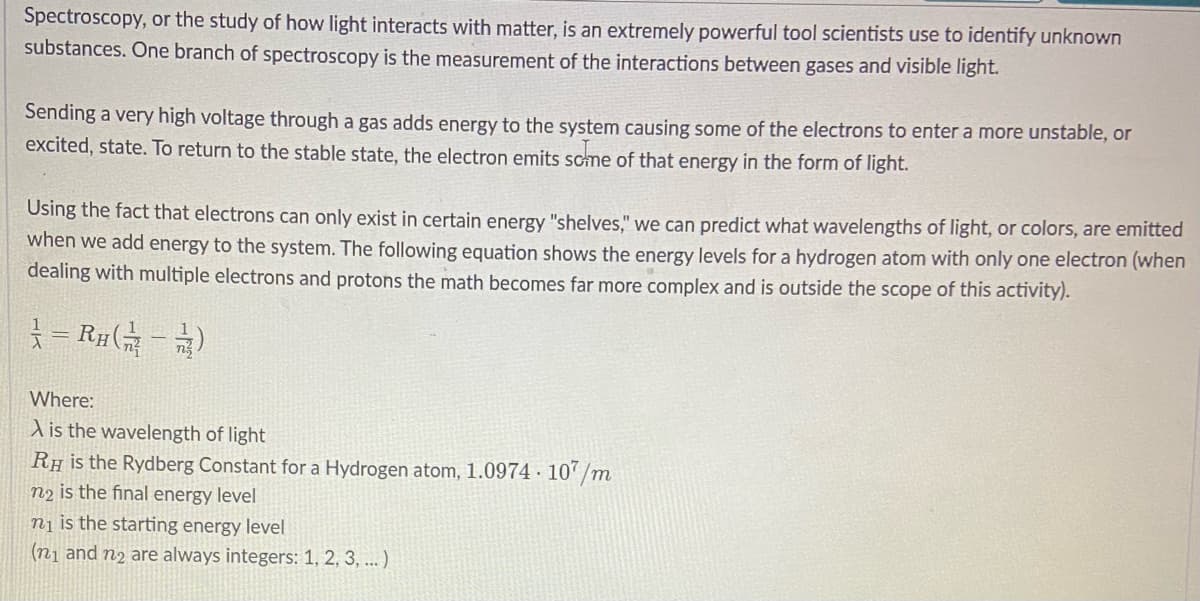2. What is the wavelength of light emitted when 4. Now let's look at what happens when we move to the second shelf, n2 = moving from the 3rd and 2nd energy levels. 486 nm 95 nm 1875 nm 656 nm
2. What is the wavelength of light emitted when 4. Now let's look at what happens when we move to the second shelf, n2 = moving from the 3rd and 2nd energy levels. 486 nm 95 nm 1875 nm 656 nm
Chemistry: Principles and Reactions
8th Edition
ISBN:9781305079373
Author:William L. Masterton, Cecile N. Hurley
Publisher:William L. Masterton, Cecile N. Hurley
Chapter6: Electronic Structure And The Periodic Table
Section: Chapter Questions
Problem 80QAP: In the photoelectric effect, electrons are ejected from a metal surface when light strikes it. A...
Related questions
Question

Transcribed Image Text:4. Now let's look at what happens when we move to the second shelf, n2 = 2. What is the wavelength of light emitted when
moving from the 3rd
| 2nd
energy levels.
and
486 nm
95 nm
1875 nm
656 nm

Transcribed Image Text:Spectroscopy, or the study of how light interacts with matter, is an extremely powerful tool scientists use to identify unknown
substances. One branch of spectroscopy is the measurement of the interactions between gases and visible light.
Sending a very high voltage through a gas adds energy to the system causing some of the electrons to enter a more unstable, or
excited, state. To return to the stable state, the electron emits scme of that energy in the form of light.
Using the fact that electrons can only exist in certain energy "shelves," we can predict what wavelengths of light, or colors, are emitted
when we add energy to the system. The following equation shows the energy levels for a hydrogen atom with only one electron (when
dealing with multiple electrons and protons the math becomes far more complex and is outside the scope of this activity).
= R#)
Where:
A is the wavelength of light|
RH is the Rydberg Constant for a Hydrogen atom, 1.0974 · 10’ /m
n2 is the final energy level
nj is the starting energy level
(n1 and n2 are always integers: 1, 2, 3, ...)
Expert Solution
This question has been solved!
Explore an expertly crafted, step-by-step solution for a thorough understanding of key concepts.
This is a popular solution!
Trending now
This is a popular solution!
Step by step
Solved in 2 steps with 2 images

Knowledge Booster
Learn more about
Need a deep-dive on the concept behind this application? Look no further. Learn more about this topic, chemistry and related others by exploring similar questions and additional content below.Recommended textbooks for you

Chemistry: Principles and Reactions
Chemistry
ISBN:
9781305079373
Author:
William L. Masterton, Cecile N. Hurley
Publisher:
Cengage Learning

Principles of Modern Chemistry
Chemistry
ISBN:
9781305079113
Author:
David W. Oxtoby, H. Pat Gillis, Laurie J. Butler
Publisher:
Cengage Learning

Chemistry: An Atoms First Approach
Chemistry
ISBN:
9781305079243
Author:
Steven S. Zumdahl, Susan A. Zumdahl
Publisher:
Cengage Learning

Chemistry: Principles and Reactions
Chemistry
ISBN:
9781305079373
Author:
William L. Masterton, Cecile N. Hurley
Publisher:
Cengage Learning

Principles of Modern Chemistry
Chemistry
ISBN:
9781305079113
Author:
David W. Oxtoby, H. Pat Gillis, Laurie J. Butler
Publisher:
Cengage Learning

Chemistry: An Atoms First Approach
Chemistry
ISBN:
9781305079243
Author:
Steven S. Zumdahl, Susan A. Zumdahl
Publisher:
Cengage Learning

Chemistry
Chemistry
ISBN:
9781305957404
Author:
Steven S. Zumdahl, Susan A. Zumdahl, Donald J. DeCoste
Publisher:
Cengage Learning


Chemistry: The Molecular Science
Chemistry
ISBN:
9781285199047
Author:
John W. Moore, Conrad L. Stanitski
Publisher:
Cengage Learning